Types of Amplifiers | Analog and Digital Electronics - Electrical Engineering (EE) PDF Download
In practical applications, the output of a single state amplifier is usually insufficient, though it is a voltage or power amplifier. Hence they are replaced by Multi-stage transistor amplifiers.
In Multi-stage amplifiers, the output of first stage is coupled to the input of next stage using a coupling device. These coupling devices can usually be a capacitor or a transformer. This process of joining two amplifier stages using a coupling device can be called as Cascading.
The following figure shows a two-stage amplifier connected in cascade.

The overall gain is the product of voltage gain of individual stages.
Where AV = Overall gain, AV1 = Voltage gain of 1st stage, and AV2 = Voltage gain of 2nd stage.
If there are n number of stages, the product of voltage gains of those n stages will be the overall gain of that multistage amplifier circuit.
Purpose of coupling device
The basic purposes of a coupling device are
To transfer the AC from the output of one stage to the input of next stage.
To block the DC to pass from the output of one stage to the input of next stage, which means to isolate the DC conditions.
Types of Coupling
Joining one amplifier stage with the other in cascade, using coupling devices form a Multi-stage amplifier circuit. There are four basic methods of coupling, using these coupling devices such as resistors, capacitors, transformers etc. Let us have an idea about them.
Resistance-Capacitance Coupling
This is the mostly used method of coupling, formed using simple resistor-capacitor combination. The capacitor which allows AC and blocks DC is the main coupling element used here.
The coupling capacitor passes the AC from the output of one stage to the input of its next stage. While blocking the DC components from DC bias voltages to effect the next stage. Let us get into the details of this method of coupling in the coming chapters.
Impedance Coupling
The coupling network that uses inductance and capacitance as coupling elements can be called as Impedance coupling network.
In this impedance coupling method, the impedance of coupling coil depends on its inductance and signal frequency which is jwL. This method is not so popular and is seldom employed.
Transformer Coupling
The coupling method that uses a transformer as the coupling device can be called as Transformer coupling. There is no capacitor used in this method of coupling because the transformer itself conveys the AC component directly to the base of second stage.
The secondary winding of the transformer provides a base return path and hence there is no need of base resistance. This coupling is popular for its efficiency and its impedance matching and hence it is mostly used.
Direct Coupling
If the previous amplifier stage is connected to the next amplifier stage directly, it is called as direct coupling. The individual amplifier stage bias conditions are so designed that the stages can be directly connected without DC isolation.
The direct coupling method is mostly used when the load is connected in series, with the output terminal of the active circuit element. For example, head-phones, loud speakers etc.
Role of Capacitors in Amplifiers
Other than the coupling purpose, there are other purposes for which few capacitors are especially employed in amplifiers. To understand this, let us know about the role of capacitors in Amplifiers.
The Input Capacitor Cin
The input capacitor Cin present at the initial stage of the amplifier, couples AC signal to the base of the transistor. This capacitor Cin if not present, the signal source will be in parallel to resistor R2 and the bias voltage of the transistor base will be changed.
Hence Cin allows, the AC signal from source to flow into input circuit, without affecting the bias conditions.
The Emitter By-pass Capacitor Ce
The emitter by-pass capacitor Ce is connected in parallel to the emitter resistor. It offers a low reactance path to the amplified AC signal.
In the absence of this capacitor, the voltage developed across RE will feedback to the input side thereby reducing the output voltage. Thus in the presence of Ce the amplified AC will pass through this.
Coupling Capacitor CC
The capacitor CC is the coupling capacitor that connects two stages and prevents DC interference between the stages and controls the operating point from shifting. This is also called as blocking capacitor because it does not allow the DC voltage to pass through it.
In the absence of this capacitor, RC will come in parallel with the resistance R1 of the biasing network of the next stage and thereby changing the biasing conditions of the next stage.
Amplifier Consideration
For an amplifier circuit, the overall gain of the amplifier is an important consideration. To achieve maximum voltage gain, let us find the most suitable transistor configuration for cascading.
CC Amplifier
- Its voltage gain is less than unity.
- It is not suitable for intermediate stages.
CB Amplifier
- Its voltage gain is less than unity.
- Hence not suitable for cascading.
CE Amplifier
- Its voltage gain is greater than unity.
- Voltage gain is further increased by cascading.
The characteristics of CE amplifier are such that, this configuration is very suitable for cascading in amplifier circuits. Hence most of the amplifier circuits use CE configuration.
RC Coupling Amplifier
The resistance-capacitance coupling is, in short termed as RC coupling. This is the mostly used coupling technique in amplifiers.
Construction of a Two-stage RC Coupled Amplifier
The constructional details of a two-stage RC coupled transistor amplifier circuit are as follows. The two stage amplifier circuit has two transistors, connected in CE configuration and a common power supply VCC is used. The potential divider network R1 and R2 and the resistor Re form the biasing and stabilization network. The emitter by-pass capacitor Ce offers a low reactance path to the signal.
The resistor RL is used as a load impedance. The input capacitor Cin present at the initial stage of the amplifier couples AC signal to the base of the transistor. The capacitor CC is the coupling capacitor that connects two stages and prevents DC interference between the stages and controls the shift of operating point. The figure below shows the circuit diagram of RC coupled amplifier.
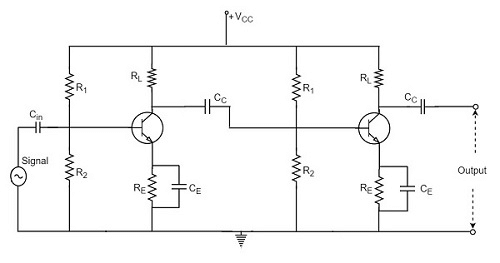
Operation of RC Coupled Amplifier
When an AC input signal is applied to the base of first transistor, it gets amplified and appears at the collector load RL which is then passed through the coupling capacitor CC to the next stage. This becomes the input of the next stage, whose amplified output again appears across its collector load. Thus the signal is amplified in stage by stage action.
The important point that has to be noted here is that the total gain is less than the product of the gains of individual stages. This is because when a second stage is made to follow the first stage, the effective load resistance of the first stage is reduced due to the shunting effect of the input resistance of the second stage. Hence, in a multistage amplifier, only the gain of the last stage remains unchanged.
As we consider a two stage amplifier here, the output phase is same as input. Because the phase reversal is done two times by the two stage CE configured amplifier circuit.
Frequency Response of RC Coupled Amplifier
Frequency response curve is a graph that indicates the relationship between voltage gain and function of frequency. The frequency response of a RC coupled amplifier is as shown in the following graph.
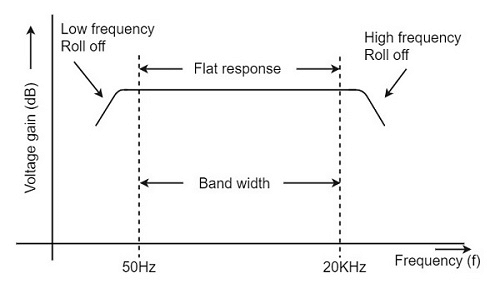
From the above graph, it is understood that the frequency rolls off or decreases for the frequencies below 50Hz and for the frequencies above 20 KHz. whereas the voltage gain for the range of frequencies between 50Hz and 20 KHz is constant.
We know that,
It means that the capacitive reactance is inversely proportional to the frequency.
At Low frequencies (i.e. below 50 Hz)
The capacitive reactance is inversely proportional to the frequency. At low frequencies, the reactance is quite high. The reactance of input capacitor Cin and the coupling capacitor CC are so high that only small part of the input signal is allowed. The reactance of the emitter by pass capacitor CE is also very high during low frequencies. Hence it cannot shunt the emitter resistance effectively. With all these factors, the voltage gain rolls off at low frequencies.
At High frequencies (i.e. above 20 KHz)
Again considering the same point, we know that the capacitive reactance is low at high frequencies. So, a capacitor behaves as a short circuit, at high frequencies. As a result of this, the loading effect of the next stage increases, which reduces the voltage gain. Along with this, as the capacitance of emitter diode decreases, it increases the base current of the transistor due to which the current gain (β) reduces. Hence the voltage gain rolls off at high frequencies.
At Mid-frequencies (i.e. 50 Hz to 20 KHz)
The voltage gain of the capacitors is maintained constant in this range of frequencies, as shown in figure. If the frequency increases, the reactance of the capacitor CC decreases which tends to increase the gain. But this lower capacitance reactive increases the loading effect of the next stage by which there is a reduction in gain.
Due to these two factors, the gain is maintained constant.
Advantages of RC Coupled Amplifier
The following are the advantages of RC coupled amplifier.
The frequency response of RC amplifier provides constant gain over a wide frequency range, hence most suitable for audio applications.
The circuit is simple and has lower cost because it employs resistors and capacitors which are cheap.
It becomes more compact with the upgrading technology.
Disadvantages of RC Coupled Amplifier
The following are the disadvantages of RC coupled amplifier.
The voltage and power gain are low because of the effective load resistance.
They become noisy with age.
Due to poor impedance matching, power transfer will be low.
Applications of RC Coupled Amplifier
The following are the applications of RC coupled amplifier.
They have excellent audio fidelity over a wide range of frequency.
Widely used as Voltage amplifiers
Due to poor impedance matching, RC coupling is rarely used in the final stages.
Transformer Coupled Amplifier
We have observed that the main drawback of RC coupled amplifier is that the effective load resistance gets reduced. This is because, the input impedance of an amplifier is low, while its output impedance is high.
When they are coupled to make a multistage amplifier, the high output impedance of one stage comes in parallel with the low input impedance of next stage. Hence, effective load resistance is decreased. This problem can be overcome by a transformer coupled amplifier.
In a transformer-coupled amplifier, the stages of amplifier are coupled using a transformer. Let us go into the constructional and operational details of a transformer coupled amplifier.
Construction of Transformer Coupled Amplifier
The amplifier circuit in which, the previous stage is connected to the next stage using a coupling transformer, is called as Transformer coupled amplifier.
The coupling transformer T1 is used to feed the output of 1st stage to the input of 2nd stage. The collector load is replaced by the primary winding of the transformer. The secondary winding is connected between the potential divider and the base of 2nd stage, which provides the input to the 2nd stage. Instead of coupling capacitor like in RC coupled amplifier, a transformer is used for coupling any two stages, in the transformer coupled amplifier circuit.
The figure below shows the circuit diagram of transformer coupled amplifier.
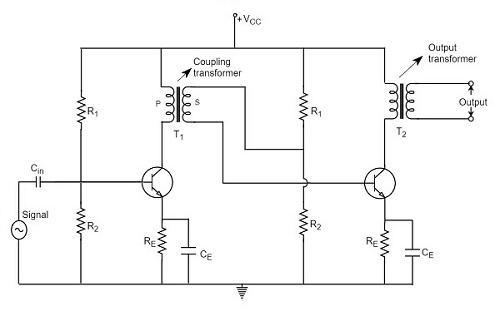
The potential divider network R1 and R2 and the resistor Re together form the biasing and stabilization network. The emitter by-pass capacitor Ce offers a low reactance path to the signal. The resistor RL is used as a load impedance. The input capacitor Cin present at the initial stage of the amplifier couples AC signal to the base of the transistor. The capacitor CC is the coupling capacitor that connects two stages and prevents DC interference between the stages and controls the shift of operating point.
Operation of Transformer Coupled Amplifier
When an AC signal is applied to the input of the base of the first transistor then it gets amplified by the transistor and appears at the collector to which the primary of the transformer is connected.
The transformer which is used as a coupling device in this circuit has the property of impedance changing, which means the low resistance of a stage (or load) can be reflected as a high load resistance to the previous stage. Hence the voltage at the primary is transferred according to the turns ratio of the secondary winding of the transformer.
This transformer coupling provides good impedance matching between the stages of amplifier. The transformer coupled amplifier is generally used for power amplification.
Frequency Response of Transformer Coupled Amplifier
The figure below shows the frequency response of a transformer coupled amplifier. The gain of the amplifier is constant only for a small range of frequencies. The output voltage is equal to the collector current multiplied by the reactance of primary.
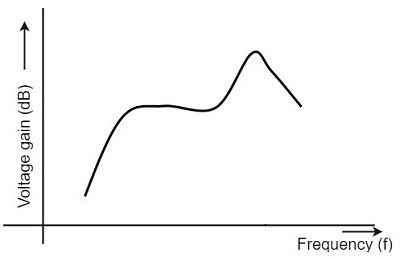
At low frequencies, the reactance of primary begins to fall, resulting in decreased gain. At high frequencies, the capacitance between turns of windings acts as a bypass condenser to reduce the output voltage and hence gain.
So, the amplification of audio signals will not be proportionate and some distortion will also get introduced, which is called as Frequency distortion.
Advantages of Transformer Coupled Amplifier
The following are the advantages of a transformer coupled amplifier −
- An excellent impedance matching is provided.
- Gain achieved is higher.
- There will be no power loss in collector and base resistors.
- Efficient in operation.
Disadvantages of Transformer Coupled Amplifier
The following are the disadvantages of a transformer coupled amplifier −
Though the gain is high, it varies considerably with frequency. Hence a poor frequency response.
Frequency distortion is higher.
Transformers tend to produce hum noise.
Transformers are bulky and costly.
Applications
The following are the applications of a transformer coupled amplifier −
- Mostly used for impedance matching purposes.
- Used for Power amplification.
- Used in applications where maximum power transfer is needed.
The other type of coupling amplifier is the direct coupled amplifier, which is especially used to amplify lower frequencies, such as amplifying photo-electric current or thermo-couple current or so.
Direct Coupled Amplifier
As no coupling devices are used, the coupling of the amplifier stages is done directly and hence called as Direct coupled amplifier.
Construction
The figure below indicates the three stage direct coupled transistor amplifier. The output of first stage transistor T1 is connected to the input of second stage transistor T2.
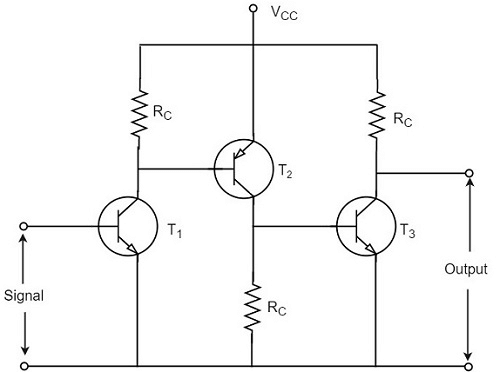
The transistor in the first stage will be an NPN transistor, while the transistor in the next stage will be a PNP transistor and so on. This is because, the variations in one transistor tend to cancel the variations in the other. The rise in the collector current and the variation in β of one transistor gets cancelled by the decrease in the other.
Operation
The input signal when applied at the base of transistor T1, it gets amplified due to the transistor action and the amplified output appears at the collector resistor Rc of transistor T1. This output is applied to the base of transistor T2 which further amplifies the signal. In this way, a signal is amplified in a direct coupled amplifier circuit.
Advantages
The advantages of direct coupled amplifier are as follows.
The circuit arrangement is simple because of minimum use of resistors.
The circuit is of low cost because of the absence of expensive coupling devices.
Disadvantages
The disadvantages of direct coupled amplifier are as follows.
- It cannot be used for amplifying high frequencies.
- The operating point is shifted due to temperature variations.
Applications
The applications of direct coupled amplifier are as follows.
- Low frequency amplifications.
- Low current amplifications.
Comparisions
Let us try to compare the characteristics of different types of coupling methods discussed till now.
| S.No | Particular | RC Coupling | Transformer Coupling | Direct Coupling |
|---|---|---|---|---|
| 1 | Frequency response | Excellent in audio frequency range | Poor | Best |
| 2 | Cost | Less | More | Least |
| 3 | Space and Weight | Less | More | Least |
| 4 | Impedance matching | Not good | Excellent | Good |
| 5 | Use | For voltage amplification | For Power amplification | For amplifying extremely low frequencies |
|
135 videos|167 docs|71 tests
|
FAQs on Types of Amplifiers - Analog and Digital Electronics - Electrical Engineering (EE)
| 1. What are the different types of coupling used in amplifiers? |  |
| 2. What is the role of capacitors in amplifiers? |  |
| 3. How is a two-stage RC coupled amplifier constructed? |  |
| 4. What is the frequency response of an RC coupled amplifier? |  |
| 5. How is a transformer coupled amplifier constructed and how does it differ from RC coupling? |  |
















